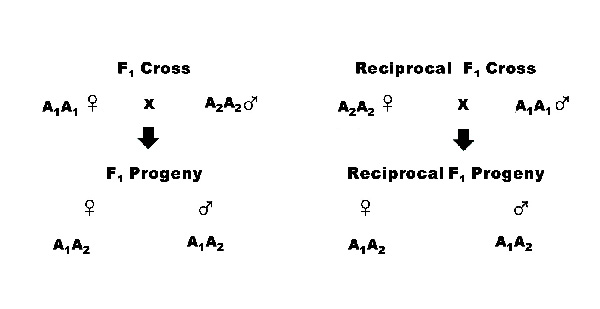Information Available from the F1 and F1 reciprocal progeny - Autosomal Inheritance
In many diploid organisms, traits can be classified as autosomal or
sex-linked. The terms autosomal and sex-linked refer to
the type of chromosomes that carry the genes. (inactive
link![]() )
Chromosomes are distinguished by their size, shape, banding patterns and
secondary constrictions (inactive link
)
Chromosomes are distinguished by their size, shape, banding patterns and
secondary constrictions (inactive link![]() ).
In diploid organisms, chromosomes come in pairs that look identical under a light
microscope. These homomorphic chromosomes have the same size, shape, banding
patterns and secondary constrictions (same shape = homomorphic). Males and females have the same sets of homomorphic chromosomes. In humans, for example, there are 22 different
autosomal pairs present in both males and females. The seven traits studied by Mendel were
autosomal.
).
In diploid organisms, chromosomes come in pairs that look identical under a light
microscope. These homomorphic chromosomes have the same size, shape, banding
patterns and secondary constrictions (same shape = homomorphic). Males and females have the same sets of homomorphic chromosomes. In humans, for example, there are 22 different
autosomal pairs present in both males and females. The seven traits studied by Mendel were
autosomal.
In many organisms there is another pair of chromosomes, the heteromorphic chromosomes, that have different shapes. These chromosomes are involved in sex determination. From the genetic point of view, sex chromosomes modify the Mendelian ratios that were derived from autosomal genes. Each modification of Mendelian ratios depends on the inheritance and on the type of sex-determination.
The table below summaries the phenotypic patterns that you expect to see in the F1 and F1 reciprocal progeny assuming autosomal inheritance.
The F1 and F1 reciprocal crosses are an unknown, homozygous mutant mated to a homozygous wildtype individual.
|
Let A1 be the mutant allele and A2 be the wildtype allele for an autosomal gene, The F1 and reciprocal F1 crosses are shown below. |
 |
|
Dominance of Mutant Allele |
Autosomal |
| Recessive Phenotype |
|
| Dominant Phenotype |
|
| Incompletely Dominant Phenotype |
|
| Overdominant Phenotype |
|
| Codominant Phenotype |
|